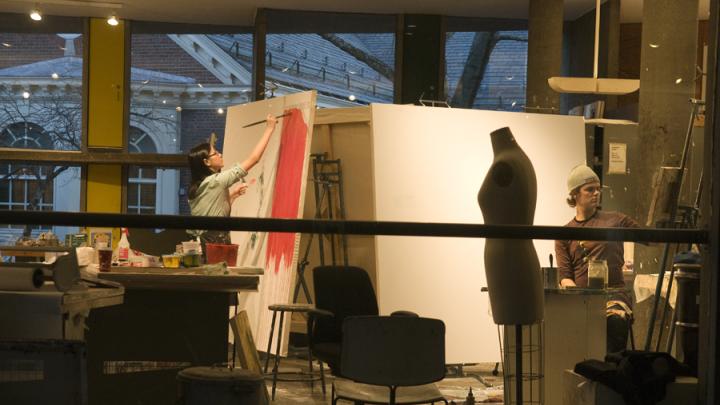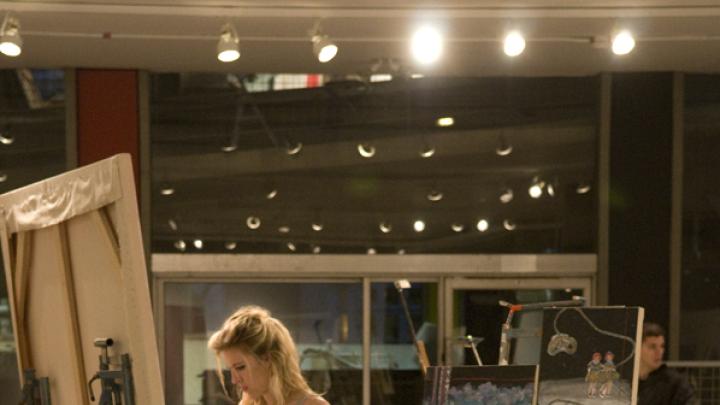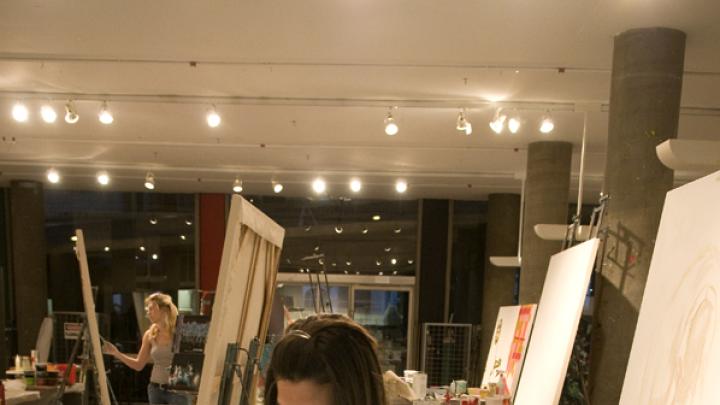The arts must assume a more central role in the intellectual life of the campus, and this goal should remain a priority even in the current bleak economic climate, a task force on the arts at Harvard exhorted in a December report.

Stephanie Mitchell/Harvard News Office
Stephen Greenblatt
The arts are “at once everywhere, and yet oddly marginalized and undervalued” at Harvard, Cogan University Professor Stephen Greenblatt, the Shakespeare scholar who headed the task force, told an Office for the Arts publication last fall. The campus’s “exceedingly vital and interesting arts scene,” he said, “was genially accepted but somehow not really important or different from other extracurriculars in the way the University viewed it.”
Toward the goal of putting the arts “on par with the study of the humanities and sciences,” the task force recommended launching new degree programs; incorporating more opportunities for art creation in the undergraduate curriculum; and building new space for the arts, as well as improving existing facilities. These undertakings will require “a substantial fund-raising effort,” the report noted.
It offered three main recommendations.
• Greater emphasis on “art-making” in the undergraduate curriculum.
Undergraduates interested in art creation have a limited selection of courses, some of which require students to have experience and skill before enrolling. With this state of affairs, the report said, “we reinforce the message that a serious curricular engagement with the arts should be reserved for a tiny cohort, and we direct all others to the broad and playful sphere of the extracurricular.”
“The creation of art—the integration of empathy, conceptual thinking, and design that art-making entails—is not a decorative add-on to an education,” Greenblatt said in the news release accompanying publication of the report. “It is central to what education, in our time or indeed any time, is about.”
Just as the new general-education curriculum encourages science courses to incorporate lab work, the arts report encouraged professors—especially those teaching courses in the “aesthetic and interpretive understanding” category—to incorporate art creation as well as analysis and theory.
The task force also recommended a new undergraduate concentration in the dramatic arts, intended to “be part of a liberal-arts education, not conservatory training.”
• New graduate programs that culminate in a master of fine arts degree.
Establishing programs in creative writing and theater should be possible within “a relatively short time” given these disciplines’ relatively well-developed state; with regard to painting, sculpture, digital media, music, and filmmaking, the report said, “different time-frames are needed.”
The report recommended full funding of all graduate-student slots in these programs, so that Harvard does not force its graduates to embark on risky, often unprofitable careers in the arts with a massive debt burden. (Concerns over graduates’ financial straits aside, Greenblatt notes that without full funding, Harvard would have a hard time attracting top students, because many peer programs are funded.)
• Investing in the construction of “new innovative arts spaces” and upgrading existing spaces.
The nascent Allston campus represents an opportunity “to bring into being precisely the architecturally exciting structures that will enable the innovations for which we are calling,” the report said. It traced the outlines of a center for the arts in Allston that brings together artist and scholar, creator and viewer, rehearsal and performance, classroom and museum.
Renovating existing spaces is not enough, the report declared: “Our existing physical structures and exhibition spaces reinforce principles in which few, if any, of us continue to believe.” It called the division between artworks, housed in the Harvard Art Museum, and ethnographic objects, gathered in the Peabody Museum, “artificial” and said such divisions “can run counter to the imperative for a more inclusive history of art, one to which, for example, the arts of Africa, Oceania, and Native America certainly belong.”
Three of Harvard’s peer institutions have major arts initiatives under way: Yale is in the midst of a $3.5-billion capital campaign that includes $500 million for its already prominent schools of architecture, art, drama, and music. Stanford’s capital campaign envisions a major expansion of creative-arts programs and faculty, and creation of a comprehensive “arts district” lining both sides of the main road into campus. Princeton also has major arts facilities in the works.
Although these plans appear to be proceeding, universities are not immune from the recession, as recent events at Harvard indicate (see “The Fiscal Crunch,” page 43). In a statement accompanying the arts report, President Drew Faust outlined how the arts might become even more important under such worrisome conditions:
Especially in difficult times, when ways of thinking and doing that we have taken for granted are challenged…we must encourage our students to ask fundamental questions and to solve problems in the inventive and collaborative ways exemplified by the making of art. Art produces experiences and objects that are carefully constructed and intricate reflections of the world. Empathy, imagination, and creativity are forms of knowledge that a university must foster in its students.…In times of uncertainty, the arts remind us of our humanity and provide the reassuring proof that we, along with the Grecian urn, have endured and will continue to do so. Now is the time to embrace, not retreat from, the arts.
In an interview, Faust and Greenblatt noted that the plan will unfold over a period of years. This process, Faust said, asks fundamental questions about the University: “What are our commitments and values as an institution? This transcends the historic moment in which we are located.”
As universities and the wider society pull back sharply on spending, Greenblatt said, it is refreshing to be taking an optimistic view and talking about possibilities, even if the time frame is the long term: “It’s a reminder that there are other things one might actually talk about and think about, aside from the doom and gloom of the current moment.”
Faust said she is working with the schools that would be involved in creating the new graduate programs. The report recommended swift formation of a task force to begin that process; Faust declined to give a time frame for any initiative, but noted that the $100-million gift the University received last year from David Rockefeller ’36, G ’37, LL.D. ’69, included money designated to support the arts (see “A Giant’s Gift,” July-August 2008, page 57).
As for the arts facilities in Allston, Faust said the administration is examining the entire Allston plan “with great scrutiny…recognizing that the pace that seemed the logical one a year ago” may no longer be viable. She noted that the Allston plan always included space for the arts (see “Art Museum Two-Step,” January-February 2008, page 62).
Beyond its three main goals, the report incorporated a number of subsidiary recommendations, from the simple (creating a centralized event-listing service) to the more complicated (a renewed agenda for art acquisition, which dropped off precipitously in the 1960s). It also advocated another complex undertaking: reviewing hiring and tenure guidelines to increase flexibility and thereby enable the hiring of more professors of arts practice, while maintaining high standards.
The report also notes things that Harvard does well, and progress thus far: McKay professor of the practice of biomedical engineering David Edwards teaches a course on idea translation that bridges art and science; a five-year program allows undergraduates to combine a bachelor’s degree at Harvard with training in music at the New England Conservatory; a new doctoral program (a collaboration between the departments of anthropology and visual and environmental studies) explores the intersection of ethnography and filmmaking; and another new Ph.D. program, in film studies, was recently approved.
For its assessment of the arts at Harvard—both strengths and weaknesses—Faust called the report itself “a great gift to this institution”: “This initial framing of ourselves and our educational purposes is one of the key contributions of this report—and that has happened, as of today.”










